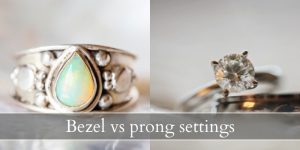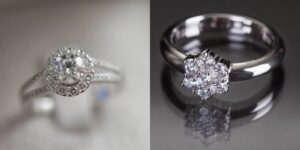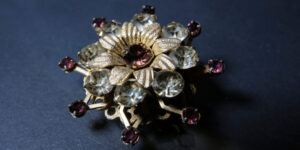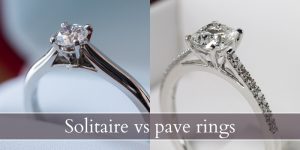When it comes time to choose the diamond setting for the stones on your engagement ring, you’re likely looking for some extra sparkle, a wow factor, something bright that catches the eye. Of all the setting styles for side stones (not the center stone !) pave and channel seem to be the most popular.
And for good reason ! Both offer a significant amount of room for a band of small diamonds, only they do this differently. So if you’re stuck between the two, take a look at this handy comparison. We’ve also added a example or two of each setting type so you can better see the differences.
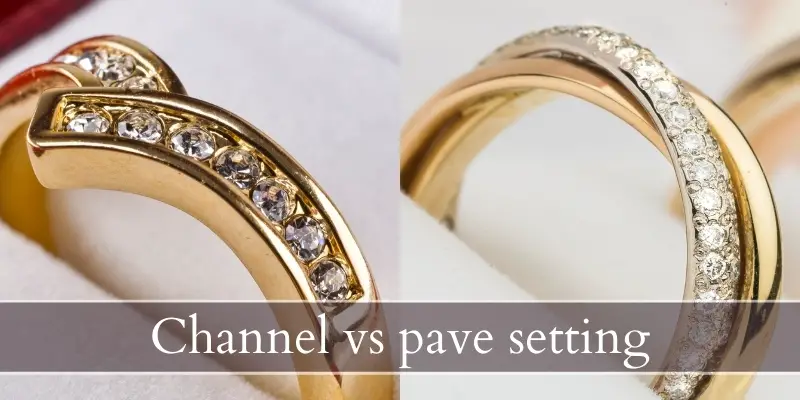
Pave vs channel setting
Channel setting has a row of diamonds nestled together into a groove that is cut into the band, with the sides of the groove holding the stones in place. Pave settings hold each stone in place with tiny beads or prongs, and look like a paved road (hence the name).
The diamonds in a pave are more exposed to the elements, but also receive more light and thus sparkle better. It’s easier to lose a pave set stone than a channel set stone, and they can easily snag on some fabrics.
Channel settings may be a bit more expensive as they use larger diamonds than pave settings, and they usually use rectangular diamonds for maximum safety.
1. Pave keeps the stones set with tiny prongs
The key difference between pave and channel is how each setting holds the diamond in place. With pave each diamond has a seat drilled into the metal band, and then part of the metal is pushed over 4 corners of the diamond, to form a mini prong or bead. This goes on for each diamond until the setting is finished. Sometimes 2 or 3 diamonds share the same bit of metal as a prong.
Here the emphasis is on the diamonds themselves, and very little metal is actually visible. If using white diamonds with white metal, the setting can be nearly invisible.
Channel settings are different, in that a long channel or groove is cut out of the metal band, and the diamonds are fit within that channel, and sit there in a tight row. The edges of the channel protect and keep the diamonds in place, and it’s also raised at least to the same level as the diamond table.
Here the emphasis is on the safety of the diamonds, and a lot of metal is showing. Even with white metal and white diamonds, the metal will be clearly visible on the top and bottom of the diamond row.
Read also: Pave VS Solitaire Rings
2. Channel setting tends to be safer for the stones
Because of this difference in how the stones are set, you’re more likely to lose a stone off a pave setting than a channel setting. To be fair, both types can be knocked out of place. But the tiny prongs holding the pave diamonds are more fragile than the entire channel. This is especially true for prongs that are shared by 2 or 3 diamonds.
So if you’ve got a very active lifestyle or work with your hands a lot, you’re better off with a channel setting than a pave setting. Of course, an even better setting would be a flushed setting, but that means significantly less sparkle. A channel setting is the next best thing.
3. Pave can use tiny diamonds, of any shape
Pave settings can take on any stone size, including very small diamonds, tiny even. When tiny diamonds are used, like on a very thin band, it’s called micropave. Because pave is so flexible in stone size, you can get a beautiful gradient work done if you want something like that. Going from a 1 ct center stone to progressively smaller down the sides, for example.
You can get graduated diamond rings that have a channel setting as well, but a pave simply does this better. Also, channel settings work better with rectangular diamonds that can easily fit next to each other. Examples include baguette, princess cut, French cut, and Asscher. Diamonds that don’t have perfectly straight edges won’t work as well in a channel setting, and dirt may end up trapped between the little stones.
4. Channel settings tend to be more comfortable on the skin
Channel settings protect the diamonds and don’t expose their edges too much. This means the skin on each neighboring finger won’t rub against prongs or rough sides, instead it’ll just glide off the metal band. This is also true for most fabrics, since the diamonds are a bit hidden in the channel. So in general wool, kashmere, silk, or any other delicate fabric shouldn’t snag as easily as with a pave setting.
The pave set is easily felt on the skin, especially f the diamond go all the way around the ring, like an eternity ring. What snags fabrics and rubs against skin ? The tiny prongs, and the exposed sides of the diamonds.
5. Pave settings bring more light into the diamonds
The flipside to those exposed diamond sides in pave is that they get much, much more light than a channel set row of diamonds. This results in greater sparkle, and if you’re after something impressive and shiny this is definitely the setting you’re looking for.
This is not to say channel setting is bland. It’s definitely not, but it scatters light differently. or rather, it doesn’t scatter as much light and all the diamonds are nestled into each other. This results in less sparkle, but the diamonds look like they’re glowing from within, in the right light.
A key point here is that much channel settings are done with baguettes or square cuts, which don’t have much sparkle to begin with.
6. Channel settings are a bit more expensive than pave
After all is said and done, channel set rings end up a little more expensive. Why ? Simply because they use bigger diamonds, and thus the total carat weight of the ring is higher, leading to a higher price. It’s more of a correlation, but that’s the general pricing. A pave may use much smaller diamonds, and the total weight would be less, even fi the total number of stones would be higher.
Of course, this is not a difference that will burn a hole in your pocket, but it’s definitely something to keep in mind.
Should you choose pave or channel ?
In the end the kind of diamond setting you choose for the ring is up to you. A pave setting is definitely more impressive and will offer an overall sparkle to the entire ring. However you risk a stone or two falling out over the years, and thus having to replace them.
A channel setting is more protective but looks bigger, and less sparkly. If you do a lot of work with your hands (beyond office work), you’re likely to need a channel setting.

I’m the main author for jewelrymaterialguide.com. I started this site after we did tons of research before our wedding and noticed that there is information about rings, jewelry, and so on that is really hard to find on the internet.

